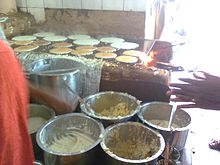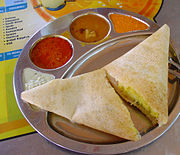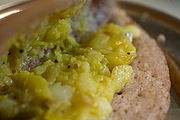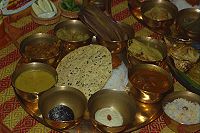- Dosa
-
Dosa /Dosai 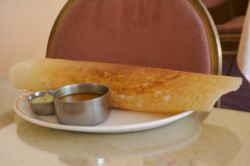
DosaOrigin Alternative name(s) Dosa, Dosay, Dose, Dosai, Dhosha, Thosai, Tosai,Chakuli Place of origin India Region or state Karnataka, Andhra Pradesh, Kerala, Tamil Nadu Dish details Main ingredient(s) rice batter and urad bean Variations masala dosa, rava dosa, onion dosa, neer dosa, paneer dosa Dosa or Dhosai(Kannada: ದೋಸೆ, Malayalam: ദോശ, Tamil: தோசை, Telugu: దోసె, Tulu: ದೋಸೆ) is a fermented crepe or pancake made from rice batter and black lentils.[1] It is indigenous to and is a staple dish in the southern Indian states of Andhra Pradesh, Karnataka, Kerala, and Tamil Nadu, as well as being popular in Sri Lanka. Dosa is also popular in Malaysia[2] and Singapore,[3] where the name Thosai is more common,[4] and in Myanmar as Toshay.
Contents
Origin
The origins of Dosa have been widely discussed in literature and books. A few of them are listed below:
- A reference to Dosa occurs in the Tamil Sangam Literature[5] from around 6th century AD.[6] Edward Farnworth mentions the first reference to Dosa in Tamil Sangam literature in the sixth century A.D.[7]
- The Sanskrit classic Manasollasa written in 1051 AD by Western Chalukya king Somesvara III describes Dosai.[8]
- Modern writers have conflicting views on the origin of Dosa. The English food writer Pat Chapman and Lisa Rayner as well as Indian writer Thangappan Nair state in their works that Dosa originated in Udupi, Karnataka.[9][10][11][12]
Orthography and transliteration
There are various ways of transliterating dosa: dose, dhosha, dosay, dosai, dhosai, tosai, thosai, or dvashi.
Nutrition
It is a common breakfast dish,[13] and street food.[14] The dosa is rich in carbohydrates, contains no salt, sugar or saturated fats and its constituent ingredients of rice and lentils mean that it is gluten-free and contains protein.[13][15] The fermentation process increases the vitamin B and vitamin C content.[16][17] There are also instant mix products for making dosa, with somewhat lower nutritional benefits.[18]
The street food variants may contain contaminants or otherwise undesirable additions, such as relatively high levels of copper.[19]
Basic preparation
Rice is ground finely to form a batter. Rice can be uncooked or parboiled. The mixture of urad dal (black lentils) and rice can be replaced with highly refined wheat flour to make a maida dosa or semolina for a rava dosa.
A thin layer of the batter is then ladled onto a hot tava (griddle) greased with oil or ghee (clarified butter). It is spread out evenly with the base of a ladle or bowl to form a pancake. It is flipped to heat both crusts and removed from the griddle when the crust becomes dry. Dosa are served hot, either folded in half or rolled like a wrap.
Serving methods
Dosa can be stuffed with fillings of vegetables and sauces to make a quick meal. They are typically served with a vegetarian side dish which varies according to regional and personal preferences. Common side items are:
- Sambar.
- Wet chutney: examples include coconut chutney (a semi-solid paste made up of coconut, dal (lentils), green chilli and mint or coriander)
- Dry chutney: a powder of spices and desiccated coconut.
- Indian pickles.
- Milagai powder: fried dry chillies, dal, asafoetida i.e., hing, salt. All the ingredients are put together and ground coarsely.
- Curd: (meaning Yogurt in Indian English) with chilli powder topping.
- Sugar: children are often given dosa with sugar instead of curries, which may be too spicy for them.
- Muddha pappu: with large amount of ghee. This is the traditional way of eating dosa in many parts of Andhra Pradesh.[citation needed]
Variations
Though dosa typically refers to the version made with rice and lentils, many other versions exist, often specific to an Indian region. Some variations include Egg dosa, which is spread with an omelette, and cheese dosa, which is stuffed with cheese.
- Chilli dosa: spread with chilli powder.
- Open dosa: chutney powder is spread on it while cooking. Before serving spiced & mashed potato is placed on top.
- Onion dosa: spread with chopped and sautéed onions.
- Ghee (thuppa/neyyi) dosa: ghee is used instead of oil while frying.
- Butter dosa: butter is used instead of oil when frying and a small amount is placed on top of it when serving.
- Roast: the dosa is spread thinly and fried until crisp.
- Kerala dosa: a different kind of traditional dosa, that is small, thick, soft and spongy. It is more like a pancake and somewhat similar to appam, but dal is used in the batter for appams and appams are not flat.
- Family roast: a long dosa which can be spread over 2 or 3 feet.
- Paper dosa: a long and very thin delicate dosa which can be spread over 2 feet.
- Green dosa: stuffed with fresh vegetables and mint chutney.
- Chow-chow dosa: stuffed with (Indian flavored) Chinese noodles.
- Masala dosa: stuffed with spiced potatoes.
- Methi dosa: flavoured with fenugreek.
- Cone dosa: shaped like a cone.
- Rava dosa: made with rava (semolina), which doesn't need fermentation and is usually considered a snack or fast food.
- Wheat dosa: made with wheat flour, and served with coconut chutney
- Vella dosa: made of jaggery with ghee or neyyi.
- 'Ragi dosa: made of ragi or millet flour, usually considered[who?] "a poor man's fare".
- Muttai dosa: eggs are added to the regular batter; the word muttai in Tamil means "egg".
- Uttapam: thick round dosa in Tamilnadu.
- Set dose: a popular type of dosa in Karnataka, which is cooked only on one side and is served in a set of two to three, hence the name.
- Benne Dose: similar to masala or set dosa but smaller in size. Served with liberal helpings of butter sprinkled on it. It is said[who?] to have originated in the Davanagere district of the state of Karnataka.
- Cabbage dosa: made out of cabbage. Paste is prepared with rice, red chillies, Asfotedia and Turmeric. Once the batter is ready, cabbage cut into small pieces is added to the paste and left for about 30 mins. Once this is done, the batter is poured and the dosa is made crisp.
- Neer dosa: prepared from rice, unique to Dakshina Kannada, Udupi and Uttara Kannada districts.[citation needed]
- 70 MM dosa: similar to Masala dosa, but it is bigger in size, about 60 cm in diameter.
- American chop suey dosa: served with a filling of fried noodles and tomato ketchup.
- Uppu puli dosa: made by adding uppu (salt) and Puli (tamarind) to the batter. It is a part of Udupi cuisine.[citation needed]
Masala dosa
A masala dosa is made by stuffing a dosa with a lightly cooked filling of potatoes, fried onions and spices. It wraps the dosa around an onion and potato curry or sabji.[clarification needed] It is listed at number 49 on World's 50 most delicious foods complied by CNN Go in 2011.[20]
Before it was invented, plain dosa was served with potato curry (batata bhaji) without onions in a separate cup. During a shortage of potatoes,[citation needed] a method was created in which potato was mashed and sautéed with onions together with other spices. This was then placed inside the dosa instead of in a separate cup in order to hide the onions, which are not eaten by orthodox Hindus and Jains.[citation needed] This came to be known as "Masala dosa", from the sautéeing of spices (masala) during the preparation of the bhaji.[citation needed]
Some variants are:
- Mysore masala dosa: masala dosa with coconut and onion chutneys spread inside along with bhaji.
- Vegetable masala dosa: instead of potatoes, peas and other vegetables are mashed to make bhaji.
- Rava masala dosa: rava (semolina), especially the Bombay Rava, is used instead of rice.
- Chinese Masala dosa: noodles and other Chinese ingredients like schezwan sauce are added.
- Paneer Chilli dosa: stuffed with sautéed cottage cheese (paneer) and capsicum.
- Palak Masala dosa: coated with a thin layer of puréed spinach, and filled with the traditional potato/onion mixture.
- Masala dosa: with one or two fried eggs served on top of it.
- Davanagere benne masala dosa: named after Davanagere in Karnataka, this is prepared by adding liberal doses of butter and also a potato filling (palya).
In Bangalore, the masala dosa is usually served with a red chutney applied to its inside surface. The red chutney usually has generous amounts of garlic,
Similar foods
- Pesarattu: a dosa-like preparation prepared from moong dal, which is typically served with a ginger and tamarind chutney in Andhra Pradesh. The variations include:
- using soaked whole moong seeds (along with green cover), which gives a greenish tint to the pesarattu; and
- using yellow coloured moong dal (green cover removed and dal is refined), which gives a golden yellow tint to it when roasted.
- Adai: a dosa-like dish prepared from a combination of dals namely Urad, Channa & Moong dal.
- Appam or Aappam or Uttapam — a pancake prepared from a combination of patted rice (Avalakki), rice & yoghurt. The primary differences between an appam and a dosa are that an appam is thicker (up to 5 times as thick as a dosa), can optionally contain curd, dough differs in ratio of rice and urud dhal and is more finely ground than dosa batter, the centre is thicker and the outer rim is very thin (whereas a dosa is more or less uniformly thick).
- Injera: a pancake-like bread made out of teff flour that is traditionally eaten in Ethiopia, Eritrea, Somalia (where it is also called canjeero or laxoox) and Yemen (where it is known as lahoh).
- Chakuli Pitha: similar to utthappam but it has more black gram and less rice flour. It is found in Oriya cuisine.[citation needed]
Media
Preparation of a plain dosaSee also
References
- ^ Shetty, Kalidas (2006). Food biotechnology. CRC Press. p. 1780. ISBN 9780824753290. http://books.google.com/books?id=E3bvD2jU4B0C&pg=PA1780. Retrieved 5 March 2011.
- ^ http://goseasia.about.com/od/malaysianculturepeople/a/malaysia_indian_food_guide.htm
- ^ http://www.lonelyplanet.com/singapore/singapore-city/restaurants/indian-vegetarian/dosa-corner
- ^ http://www.metropolasia.com/Dosa_Corner
- ^ The Hindu : Epiphany and the Idli
- ^ Handbook of fermented functional foods - Google Books
- ^ Edward R. Farnworth. Handbook of fermented functional foods. CRC Press. p. 11. http://books.google.co.in/books?id=7LYHFGLJQNQC&pg=PA11&lpg=PA11&dq=dosa+tamil+sangam+literature#v=onepage&q=dosa%20tamil%20sangam%20literature&f=false.
- ^ K. T. Achaya (May 12, 1994). Indian Food: A Historical Companion. Oxford University Press, USA. p. 90. ISBN 978-0195634488.
- ^ Raja M - The dosa, like most other south Indian culinary exports, is often linked to Udipi, a small temple town in the state of Karnataka. "India's new offering to curry Western flavor". Asia Times, June 24, 2004. http://www.atimes.com/atimes/South_Asia/FA24Df05.html. Retrieved 2010-08-23.
- ^ Lisa Rayner (2009). Wild Bread: Hand-baked Sourdough Artisan Breads in Your Own Kitchen (First ed.). Lifeweaver LLC Flagstaff, AZ. p. 132. ISBN 978-0-98006081-2. http://books.google.co.in/books?id=dFm-WunfbmoC&pg=PA132&dq.
- ^ Pat Chapman (2007). India: Food & Cooking: The Ultimate Book on Indian Cuisine. New Holland Publishers (UK) Ltd. p. 40. ISBN 978 184537 619 2. http://books.google.co.in/books?id=orHWFRMKf4EC&pg=PA40&dq#v=onepage&q&f=false.
- ^ P. Thankappan Nair and Punthi Pustak (2004). South Indians in Kolkata: history of Kannadigas, Konkanis, Malayalees, Tamilians, Telugus, South Indian dishes, and Tippoo Sultan's heirs in Calcutta. p. 396. ISBN 81-86791-50-7. http://books.google.com/books?id=swNuAAAAMAAJ&q=%22Dosa%22+%22indigenous%22+%22Karnataka%22&dq=%22Dosa%22+%22indigenous%22+%22Karnataka%22&pgis=1.
- ^ a b "Eat healthy: dosa". livestrong.com. http://www.livestrong.com/thedailyplate/nutrition-calories/food/generic/dosa/. Retrieved 2011-05-21.
- ^ Dalal, Tarla. Mumbai Roadside Snacks. Sanjay & Co.. p. 3. ISBN 9788189491666. http://books.google.com/books?id=4kjEPd1NmmkC&pg=PA3.
- ^ Srilakshmi, B. (2006) [2002]. Nutrition Science (Revised 2nd ed.). New Age International (formerly Wiley Eastern Ltd.). p. 403. ISBN 9788122416336. http://books.google.com/books?id=f_i7j4_cMLIC&pg=PA403. Retrieved 2011-05-22.
- ^ Pal, Dr J. S. (December 2006). "Traditional Indian Foods: Physio-Chemical Aspects". PFNDAI Bulletin: 3. http://www.pfndai.com/Dec06.pdf. Retrieved 2011-05-22.
- ^ Nutrition and Dietetics - Higher Secondary - First Year. Directorate of School Education, Government of Tamil Nadu. 2004. p. 31. http://www.textbooksonline.tn.nic.in/Books/11/Std11-Nutr-EM.pdf. Retrieved 2011-05-22.
- ^ "Calories in Dosa (Pan Cake)". calorie count. http://caloriecount.about.com/calories-mtr-dosa-pan-cake-i174221. Retrieved 2011-05-21.
- ^ Simopoulos, Artemis P.; Bhat, Ramesh Venkataramana (2000). Street foods - World review of nutrition and dietetics. Nutritional Triggers for Health and in Disease. 86. Karger Publishers. pp. 74, 78. ISBN 9783805569279. http://books.google.com/books?id=QQgwVl22fXkC.
- ^ CNN Go World's 50 most delicious foods 21 July 2011. Retrieved 2011-10-11
 Indian breads
Indian breadsBaati • Bhakri • Bhatoora • Chapati • Davanagere Benne Dosa • Dosa • Idli • Jolada rotti • Kerala porotta • Khakhra • Kulcha • Luchi • Makki di roti • Manda Pitha • Naan • Neer dosa • Papadum • Paratha • Parotta • Pathiri • Pesarattu • Pitha • Puri (food) • Puttu • Rava dosa • Roti • Rumali Roti • Sheermal • Thalipeeth • Uttapam
Flatbreads Asia Barbari bread • Bazlama • Bhakri • Bhatoora • Bindaetteok • Bing • Bolani • Chapati • Dosa • Kulcha • Roast paan • Gözleme • Green onion pancake • Khanom buang • Laobing • Luchi • Malooga • Markook • Matzo • Naan • Papadum • Paratha • Pesarattu • Pita • Puri • Roti • Roti canai • Sanchuisanda • Sangak • Tandyr nan • Taboon bread • Yufka
Europe Crêpe • Crisp bread • Farl • Flammkuchen • Flatbrød • Flatkaka • Focaccia • Hoggan • Lavash • Lefse • Opłatek • Pancake • Pane carasau • Piadina • Pita • Podpłomyk • Rieska • Sacramental bread • Tunnbröd
Africa Aish Mehahra • Harsha • Injera • Lahoh • Mandezi • Ngome
Americas Arepa • Bammy • Casabe • Tortilla • Tortilla de Rescoldo
Bread Types Ingredients Equipment Processes Autolysis • Chorleywood bread process • Leavening • Maillard reaction • Proofing • Kneading • Baking • SteamingUses Other Breadmaking • Baker percentageCategories:- Andhra cuisine
- Fermented foods
- Indian breads
- Indian fast food
- Karnataka cuisine
- Malaysian cuisine
- Mangalorean cuisine
- Pancakes
- Singaporean cuisine
- Tamil cuisine
Wikimedia Foundation. 2010.



